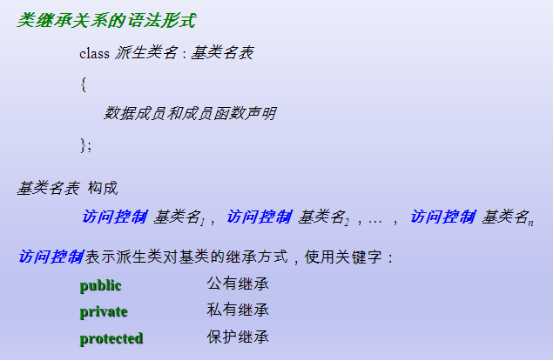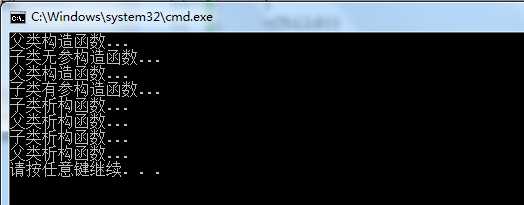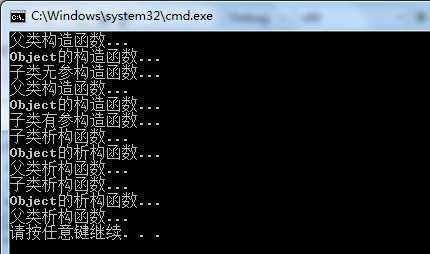标签:派生类 add nbsp 兼容性 联系 object 级别 let ace
目录:
一,继承的基本概念
1.类与类之间的关系
2.继承的相关概念
万事万物皆有继承这个现象,所谓的继承就是一个类继承了另一个类的属性和方法,这个新的类包含了上一个类的属性和方法,被称为子类或者派生类,被继承的类称为父类或者基类。
3.继承的特点
4.继承的语法

二,继承中的访问控制
1.继承的访问控制方式
我们在一个类中可以对成员变量和成员函数进行访问控制,通过C++提供的三种权限修饰符实现。在子类继承父类时,C++提供的三种权限修饰符也可以在继承的时候使用,分别为公有继承,保护继承和私有继承。这三种不同的继承方式会改变子类对父类属性和方法的访问。
2.三种继承方式对子类访问的影响
3.父类如何设置子类的访问
三,继承中的构造和析构函数
1.父类的构造和析构
当创建一个对象和销毁一个对象时,对象的构造函数和析构函数会相应的被C++编译器调用。当在继承中,父类的构造和析构函数是如何在子类中进行调用的呢,C++规定我们在子类对象构造时,需要调用父类的构造函数完成对对继承而来的成员进行初始化,同理,在析构子类对象时,需要调用父类的析构函数对其继承而来的成员进行析构。
2.父类中的构造和析构执行顺序
3.继承中的构造函数示例
# include<iostream> using namespace std; class Parent { protected: char * str; public: Parent(char * str) { if (str != NULL) { this->str = new char[strlen(str) + 1]; strcpy(this->str, str); } else { this->str = NULL; } cout << "父类构造函数..." << endl; } ~Parent() { if (this->str != NULL) { delete[] this->str; this->str = NULL; } cout << "父类析构函数..." << endl; } }; class Child:public Parent { private: char * name; int age; public: /* 在构造子类对象时,调用父类的构造函数 */ Child():Parent(NULL) { this->name = NULL; this->age = 0; cout << "子类无参构造函数..." << endl; } /* 在构造子类对象时,调用父类的构造函数 */ Child(char * name,int age):Parent(name) { this->name = new char[strlen(name) + 1]; strcpy(this->name, name); cout << "子类有参构造函数..." << endl; } ~Child() { if (this->name != NULL) { delete[] this->name; this->name = NULL; } cout << "子类析构函数..." << endl; } }; int main() { Child c1; Child c2("王刚",22); return 0; }
输出结果:

4.继承与组合情况混搭下的构造析构函数调用顺序
5.继承和组合情况混搭情况下的代码演示
# include<iostream> using namespace std; /* 定义父类 */ class Parent { protected: char * str; public: Parent(char * str) { if (str != NULL) { this->str = new char[strlen(str) + 1]; strcpy(this->str, str); } else { this->str = NULL; } cout << "父类构造函数..." << endl; } ~Parent() { if (this->str != NULL) { delete[] this->str; this->str = NULL; } cout << "父类析构函数..." << endl; } }; /* 定义Object类 */ class Object { private: int i; public: Object(int i) { this->i = i; cout << "Object的构造函数..." << endl; } ~Object() { cout << "Object的析构函数..." << endl; } }; /* 定义子类 */ class Child:public Parent { private: /* 定义类成员变量 */ Object obj; char * name; int age; public: /* 在构造子类对象时,调用父类的构造函数和调用成员变量的构造函数 */ Child():Parent(NULL),obj(10) { this->name = NULL; this->age = 0; cout << "子类无参构造函数..." << endl; } /* 在构造子类对象时,调用父类的构造函数和调用成员变量的构造函数 */ Child(char * name,int age):Parent(name),obj(age) { this->name = new char[strlen(name) + 1]; strcpy(this->name, name); cout << "子类有参构造函数..." << endl; } ~Child() { if (this->name != NULL) { delete[] this->name; this->name = NULL; } cout << "子类析构函数..." << endl; } }; int main() { Child c1; Child c2("王刚",22); return 0; }
输出结果:

四,继承中的类型兼容性原则
1.继承中的同名成员
当在继承中,如果父类的成员和子类的成员属性名称相同,我们可以通过作用域操作符来显式的使用父类的成员,如果我们不使用作用域操作符,默认使用的是子类的成员属性。
2.继承中的同名成员演示
# include<iostream> using namespace std; class PP { public: int i; }; class CC:public PP { public: int i; public: void test() { /* 使用父类的同名成员 */ PP::i = 10; /* 使用子类的同名成员 */ i = 100; } void print() { cout << "父类:" << PP::i << "," << "子类:" << i << endl; } }; int main() { CC cc; cc.test(); cc.print(); return 0; }
3.类型兼容性原则
类型兼容性原则是指在需要父类对象的所有地方,都可以用公有继承的子类对象来替代。通过公有继承,子类获得了父类除构造和析构之外的所有属性和方法,这样子类就具有了父类的所有功能,凡是父类可以解决的问题,子类也一定可以解决。
4.类型兼容性原则可以替代的情况
5.类型兼容性原则示例
# include<iostream> using namespace std; /* 创建父类 */ class MyParent { protected: char * name; public: MyParent() { name = "HelloWorld"; } void print() { cout << "name = " << name << endl; } }; /* 创建子类 */ class MyChild:public MyParent { protected: int i; public: MyChild() { i = 100; name = "I am Child"; } }; void main() { /* 定义子类对象 */ MyChild c; /* 用子类对象当做父类对象使用 */ c.print(); /* 用子类对象初始化父类对象 */ MyParent p1 = c; p1.print(); /* 父类指针直接指向子类对象 */ MyParent * p2 = &c; p2->print(); /* 父类对象直接引用子类对象 */ MyParent& p3 = c; p3.print(); }
6.继承中的static
7.继承中的static演示
# include<iostream> using namespace std; /* 父类 */ class MyP { public: static int i; }; /* 初始化静态成员 */ int MyP::i = 10; /* 子类 */ class MyC:public MyP { public: void test() { /* 直接访问 */ cout << "i = " << i << endl; /* 通过父类访问 */ cout << "Myp::i = " << MyP::i << endl; /* 通过子类访问 */ cout << "MyC::i = " << MyC::i << endl; } void add() { i++; } }; int main() { MyC c; c.add(); c.test(); MyC c1; c1.add(); c1.test(); /* 通过子类对象访问 */ c1.i = 100; c1.test(); return 0; }
五,多继承
1.C++中的多继承
所谓的多继承就是指一个子类可以继承多个父类,子类可以获取多个父类的属性和方法。这种继承方式是不被推荐的,但是C++还是添加了,事实证明,多继承增加了代码的复杂度,而且任何可以通过多继承解决的问题都可以通过单继承的方式解决。多继承和单继承的基本知识是相同的。不需要再阐述,主要讲解下面的不同的地方。
2,多继承中的构造和析构
和单继承类似,还是首先执行父类的构造函数,此时有多个构造函数,则按照继承时的父类顺序来执行相应父类的构造函数,析构函数与此相反。
3.多继承中的二义性
一个类A,它有两个子类B1和B2,然后类C多继承自B1和B2,此时如果我们使用类A里面的属性,则根据上面的多继承的构造和析构,发现此时的类A会被创造两个对象,一个是B1一个是B2,此时使用A里面的属性则会出现编译器无法知道是使用B1的还是B2的。因此C++为我们提供了虚继承这个概念,即B1和B2虚继承自A,则在构造A对象的时候,只创建一个A的对象。
4.多继承的二义性代码示例
此时如果去除virtual关键字,尝试一下会报错。
# include<iostream> using namespace std; /* 类B */ class B { public: int a; }; /* 虚继承自类B */ class B1 :virtual public B { }; /* 虚继承自类B */ class B2 :virtual public B { }; /* 继承自B1,B2 */ class C :public B1, public B2 { }; void main() { C c; c.B::a = 100; cout << c.B::a << endl; cout << c.B1::a << endl; cout << c.B2::a << endl; }
标签:派生类 add nbsp 兼容性 联系 object 级别 let ace
原文地址:http://www.cnblogs.com/metalsteel/p/6280389.html